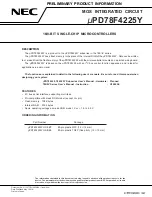
DM9000A
APPLICATION NOTES
Preliminary 33
Version: DM9000A-AN-V121
November 27, 2007
6 The Others
6.1 How to transmit and receive more than 2048-byte packets
If a system transmits or receives more than 2048-byte packets, which size is although over
802.3 spec., the TCR (REG. 02) Bit [6] TJDIS and RCR Bit [6] WTDIS should be set to "1".
For example,
#define TCR
0x02
#define RCR
0x05
iow ( TCR , ior ( TCR ) | 0x40 );
iow ( RCR , ior ( RCR ) | 0x40 );
6.2 The performance of DM9000A
The performance of the DM9000A is depended on the capability of MPU/ MCU. If the
MPU/MCU is so fastest to match the timing of the maximum speed for the DM9000A IOR#/
IOW#, the performance will be: 10ns + 10ns = 20ns -> 50Mbps.
Receive or transmit data
->
8 * 50Mbps
->
400 Mbps
8-bit mode
RX & TX data at the same time
->
8 * 50Mbps/ 2
->
200 Mbps
Receive or transmit data
->
16 * 50Mbps
->
800 Mbps
16-bit mode
RX & TX data at the same time
->
16 * 50Mbps/ 2
->
400 Mbps
Note: The DM9000A is the 10/100 Mbps Ethernet NIC, so the maximum speed is 100 Mbps.
6.3 WOL (Wake-up on LAN)
The DM9000A LAN chip also supports the WOL function and the pin 22 WAKE (or the pin 38
LED2, if setting the EEPROM Word 7 Bit [13:12] = 10 in 16-bit mode) output the wake-up
signal to the embedded system. There are three methods to generate WOL signals, which are
the Magic Packet, the Link Change, and the Sample Frame types. This section will discuss
how to implement the WOL function in the DM9000A MAC.






































